Examples of e-learning: Clear and actionable ideas
Explore real-world examples of e-learning that work. From microlearning to gamification, discover which formats fit which goals—and get inspired to use them in your own training.
In learning, one size doesn’t fit all. As a Customer Success Coach at FLOWSPARKS, I work with a wide variety of organizations, each with their own goals, target audiences, and ways of working. To match all these different learning needs, we need a variety of e-learning types.
.avif)
In this blog article, I’ll share some real-world learning needs I often come across in my role. For different needs I’ll provide examples of e-learning approaches that work well—based on what I’ve seen succeed in practice. Whether you’re designing training for onboarding, compliance, product knowledge, or soft skills, these examples of e-learning can inspire you to choose the right format for your goal.
What is e-learning and why is it important?
Before we dive a bit deeper in the e-learning world, we need a good understanding of what e-learning is.
E-learning, or online learning, is a form of self-paced training delivered via the internet. It allows learners to complete courses anytime, anywhere, and independently, without the need for a trainer or physical classroom. Everything happens online, giving maximum flexibility to both the learner and the organization.
E-learning is especially valuable when you need to reach large groups: you make training available across different locations and time zones. That makes it possible to support just-in-time learning: give people the opportunity to learn when they need it. But also, to send a consistent message to all your employees. Plus, it helps reduce training costs significantly.
What makes e-learning effective?
E-learning can be attractive and user-friendly, but that’s not enough. The goal is not just to create something nice, but something effective.
To achieve that, it’s essential to align the e-learning with the learning goals and the target audience. Ask yourself:
- What is the purpose of this training?
- What structure makes sense?
- Which knowledge or skills should learners gain?
- Who are the learners, and what do they need?
Therefore, there is no one-size-fits-all approach. Every e-learning should be tailored to fit its specific context.
Equally important is interactivity. People learn better when they are actively involved. Just reading or watching isn’t enough to make the content stick. That’s why it’s important to include interactive elements like questions, scenarios, and feedback to encourage engagement and deeper learning.
When does e-learning fail?
One of the main reasons e-learning fails is a lack of alignment with the specific context.
This can happen in different ways: the target group isn’t taken into account, the chosen format doesn’t match the learning need, or the message is unclear or unfocused.
That’s why it’s so important to start with the basics:
- Why are we creating this e-learning? What is the intended outcome?
- Who is the training for? What are their needs, background, and context?
If you skip these questions, you risk developing something that looks good but lacks real learning impact. Effective e-learning always starts with purpose and relevance.
What are examples of e-learning that can be used for different learning goals
There are many types of e-learning, each with its own strengths. At FLOWSPARKS, we help organizations meet a wide range of learning needs through various formats—each built around a specific didactic principle. These ready-to-use formats make it easy to create effective digital training that aligns with your goals, audience, and content. Let’s take a look at a few examples of e-learning types that can be applied in different situations
1. Microlearning
Firstly, we have microlearning. Microlearning refers to short, focused digital training that typically takes just three to five minutes to complete. Learners can easily consume these bite-sized modules, which often use a mix of media like video, animation, podcasts, text, or short quizzes. The power lies in its compact and flexible format.
What makes microlearning so valuable is its versatility. Despite the short length, microlearning can serve many goals: knowledge transfer, practice, testing, or reinforcing key concepts. For example a knowledge transfer with a video, an exercise to adapt what they saw in the video to practice the learning content, a test to assess current knowledge in the organization,...
Because it’s so flexible, microlearning fits well into the daily workflow and can be a powerful tool to reinforce or refresh knowledge over time.
2. Scenario based learning
Secondly, scenario-based learning places the learner in realistic situations and challenges them to make decisions. It’s ideal for practicing behaviour and dealing with real-life challenges.
This type of learning is ideal for topics where context matters, such as handling policy violations, managing difficult conversations, or navigating situations that regularly occur in the workplace. By simulating real challenges, learners can reflect, make choices, and better prepare for similar situations on the job.
3. Video based learning
Thirdly, we have video-based learning. Video-based learning uses video as the main medium to transfer knowledge or demonstrate a process. It’s effective for explanation, showcasing procedures, or even storytelling.
You can make it interactive by adding follow-up questions or decision points. This way, learners stay engaged and better connect theory to practice.
4. Game based learning/gamification
Incorporating game elements in an e-learning module is a good way to motivate people. Game-based learning goes beyond actual games: think of leaderboards, earning badges, scoring points, or interactive quizzes.
It’s often used to increase engagement and help learners practice content repeatedly. The competitive aspect can stimulate active learning.
5. Social learning
With social learning we mean all learning through social interaction and collaboration. It is obvious in a live environment but in a context of e-learning, this might include seeing how others answered a question, using forums, attending webinars, or reading peer reviews. It sparks curiosity, invites comparison, and motivates learners to explore content more deeply.
6. Self reflection
Last but not least, self-reflection in learning is the conscious process of thinking about your own learning, behaviour, thought patterns, and experiences with the goal of gaining insight and improving yourself. It’s not about consuming content but about gaining insight into your own strengths and areas for development. This kind of learning supports personal growth and helps individuals connect learning to their own experiences.
Real-world examples of e-learning: What to use and when
Here are some practical examples of e-learning that show how different e-learning types meet different learning needs. Every case is different, so always consider your audience and learning goals.
How STORYWISE enhanced policy training
One of our customers had just developed a new code of conduct. During the analysis, it became clear why this update was needed: a series of minor incidents had led the steering committee to tighten the rules. Apart from a short mention during onboarding, there were no concrete actions to support the application of the code.
Therefore, we recommended using the STORYWISE format. The rules were grouped in themes, each illustrated with a relevant dilemma. This ensured that all topics were addressed in a practical, relatable way. This approach is a good example of scenario-based learning: it encourages reflection and supports real-world application. Thanks to STORYWISE, the customer now has a system that not only tracks completion but also brings the code of conduct to life.
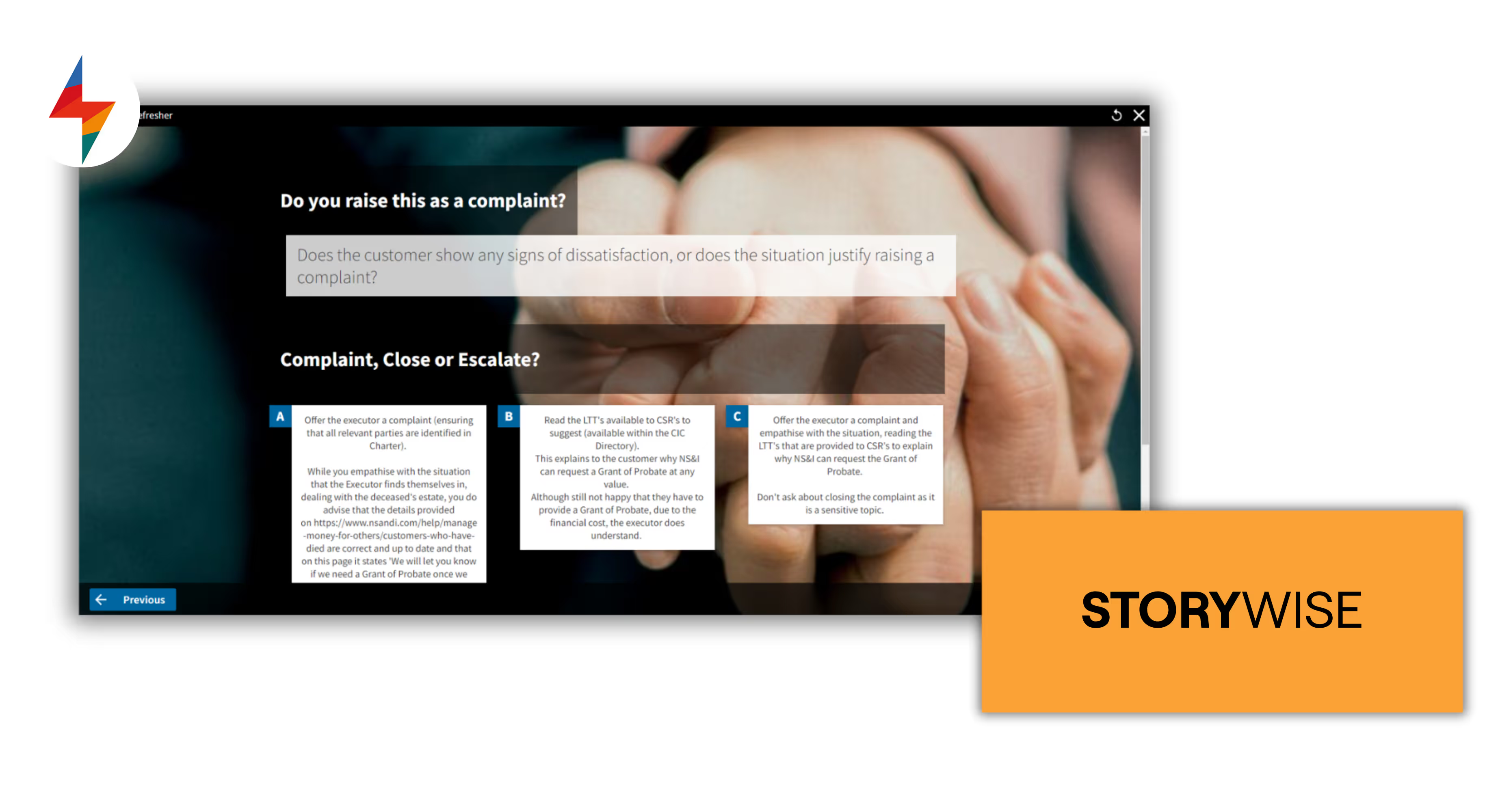
Step-by-step software training through microlearning
One of our customers introduced new products, which also required an update of the ordering software. Employees needed support not only to understand the new products, but also to work fluently with the updated system.
Together, we identified the key processes and created one case per process. The team developed each case in a TASKSTEPS format, combining a Walkthrough with a realistic example and a Practice activity using a different case. This way, employees could first see how it works and then apply their knowledge in a safe environment.
By breaking down the training into short, targeted modules, we ensured that employees could learn the new software in small, manageable steps—fully in line with the principles of microlearning.
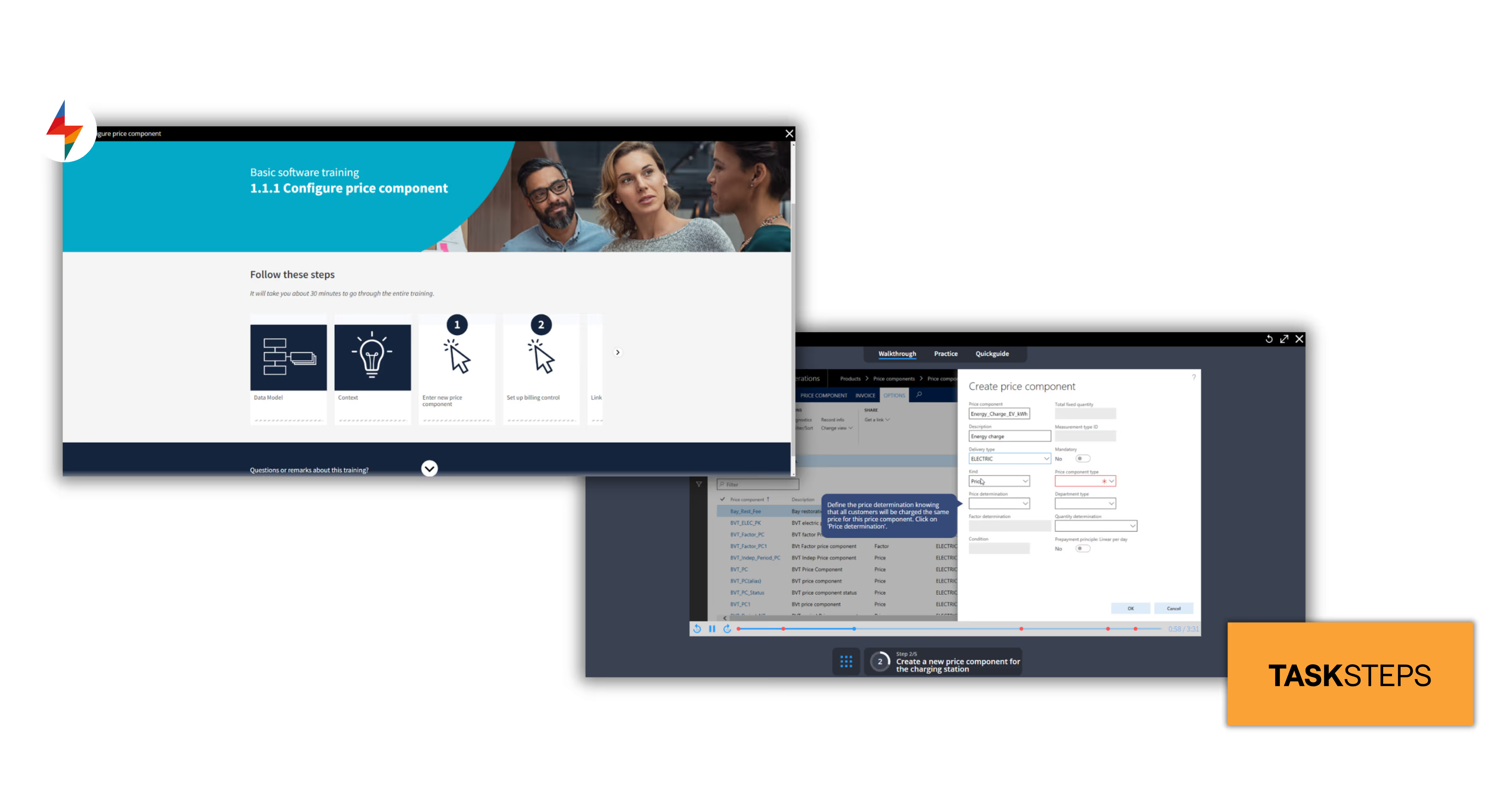
Turning sales product training into fun
New salespeople found it hard to memorise the many products, features, and applications—despite having fact sheets available. The goal of this customer was ensuring that salespeople could confidently link each product to its use in customer conversations. FLASHCARDS was a perfect fit in this case. This game-based learning format added competition and repetition, making product knowledge stick. One question had to be answered correctly twice, reducing guessing and increasing engagement.
Salespeople quickly took ownership of the content, motivated by the ranking and eager to apply what they learned in real conversations. FLASHCARDS now helps the customer keep product knowledge sharp—through fun, focused learning.
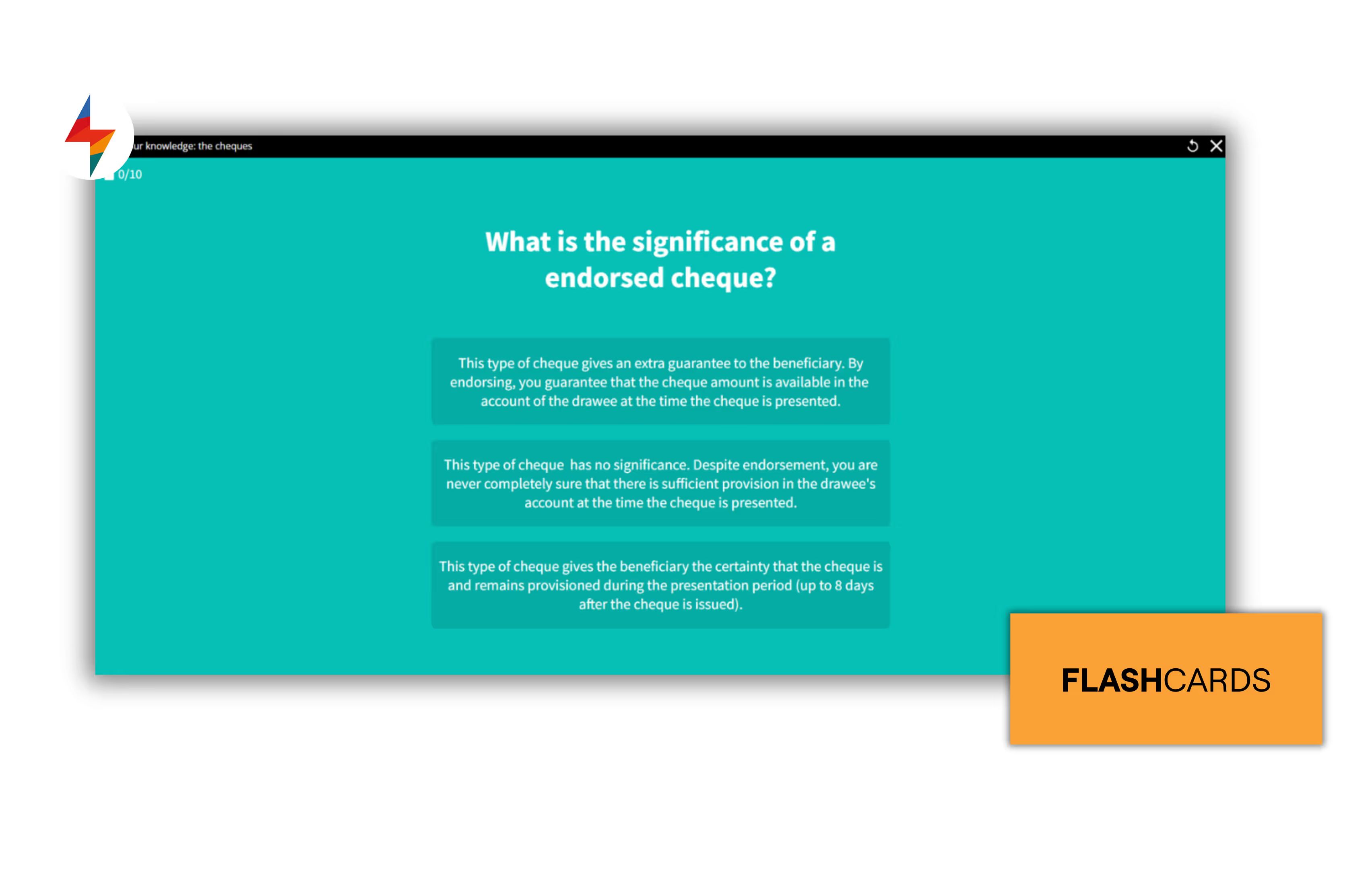
Upskill with a purpose, not overload
The customer wanted to invest in upskilling and reskilling their employees but in a way that matched individual needs and priorities. They aimed to strengthen knowledge and skills around key topics like artificial intelligence, networking, cloud, and cybersecurity. But soon realised: it’s a lot of information, and not everything is equally relevant for every employee.
To avoid a one-size-fits-all approach, they wanted employees to reflect on their current skill levels and receive tailored training suggestions. That’s where the QUICKSCAN was used. This template allows learners to rate themselves on a series of statements. Based on their responses, they receive a personalised overview of their strengths and development points—along with suggestions for relevant training. By combining self-reflection with targeted recommendations, the customer supports employees in taking ownership of their learning path—while focusing on what matters most.
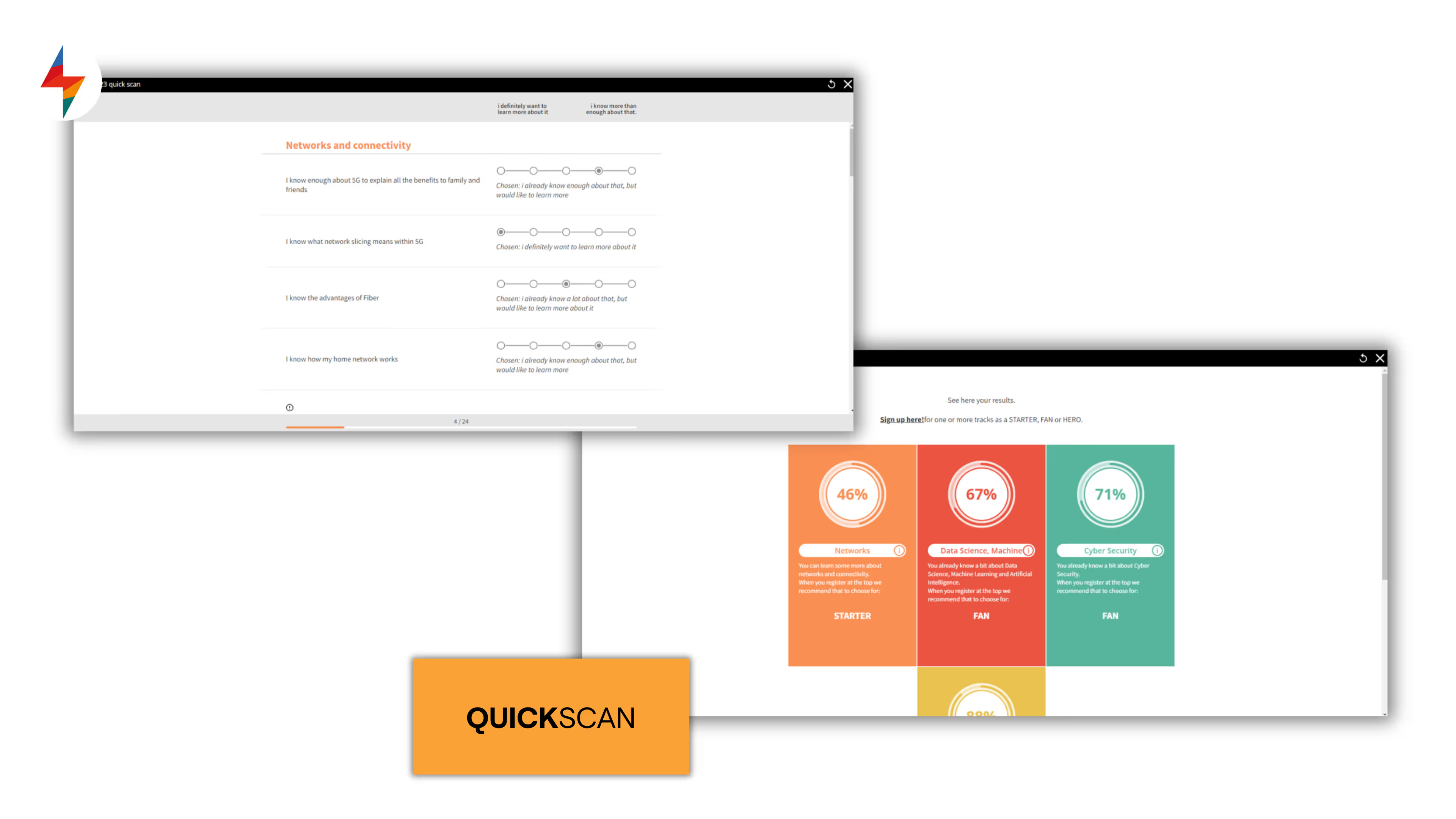
Support critical thinking in healthcare
One of our customers in the medical sector needed to train healthcare professionals on sometimes controversial topics, such as medication use, fall prevention, and dementia. These are complex themes, where situations don’t always have one clear answer and where opinions can differ depending on experience or context.
To support reflection and discussion, we used the CASESTUDY format. Each module presented a detailed patient file, followed by a series of scenario-based questions that required professionals to assess the situation and make a decision. On top of that, some questions were set up as polls, allowing learners to see how their choices compared to those of their peers.
This approach is one of the most thoughtful examples of e-learning I’ve encountered—encouraging both critical thinking and awareness of alternative perspectives, which are essential skills in a healthcare context. By blending scenario-based learning with peer insights, the training helped professionals learn from both the case and each other.
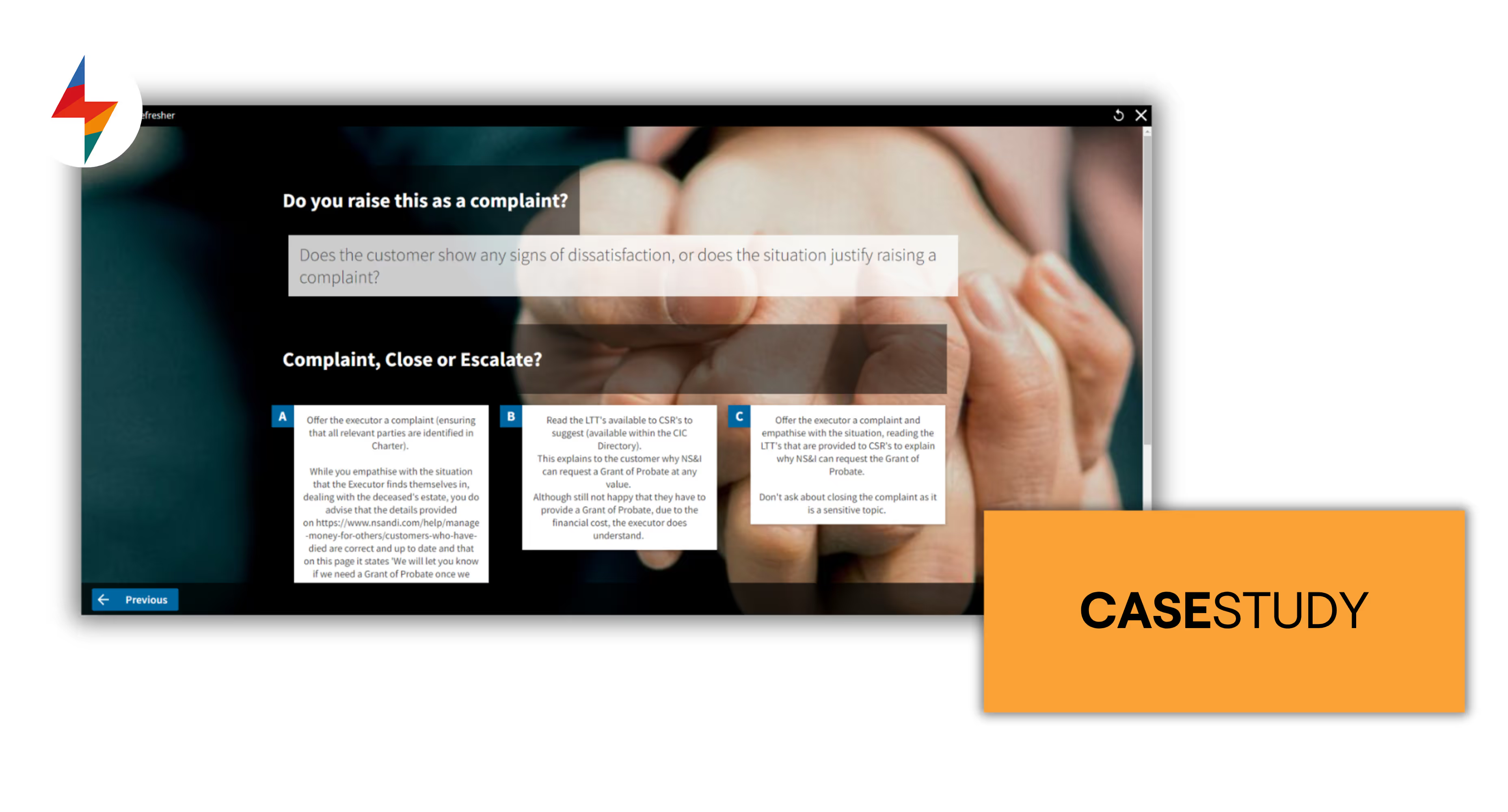
My experience with FLOWSPARKS and why you should try it
What I really like about FLOWSPARKS is the flexibility. There are so many templates to choose from, each built around a specific type of e-learning and linked to clear learning goals. As a coach, I work with customers across sectors, each with their own topics and target groups. No matter the situation, there’s always a template that fits. That makes it easy to translate a learning goal into the right format and to create e-learning that’s not just beautiful, but also effective.
Frequently Asked Questions
⚡What is an example of elearning?
Examples include microlearning, scenario-based learning, gamification, video-based training, and self-reflection formats—each tailored to different learning goals like onboarding, compliance, or soft skills.
⚡What makes elearning effective?
Effective e-learning aligns with learning goals and audience needs. It includes interactive elements like questions, scenarios, and feedback to engage learners and help them retain knowledge.
⚡What is elearning and what makes it important?
E-learning is self-paced online training that learners can complete anytime, anywhere. It's ideal for reaching large groups, ensuring consistency, enabling just-in-time learning, and reducing training costs.
.avif)
Are you looking to scale up your digital training efforts
inside your organization?
Schedule a demo and discover how FLOWSPARKS helps create and deliver engaging e-Learning experiences backed by strong instructional design principles in multiple languages without a hassle.
More interesting reads

.avif)
Adaptive learning technology explained: Benefits, examples and the 15 best platforms

.avif)
How do I create interactive e-learning content? 2025 tips & examples
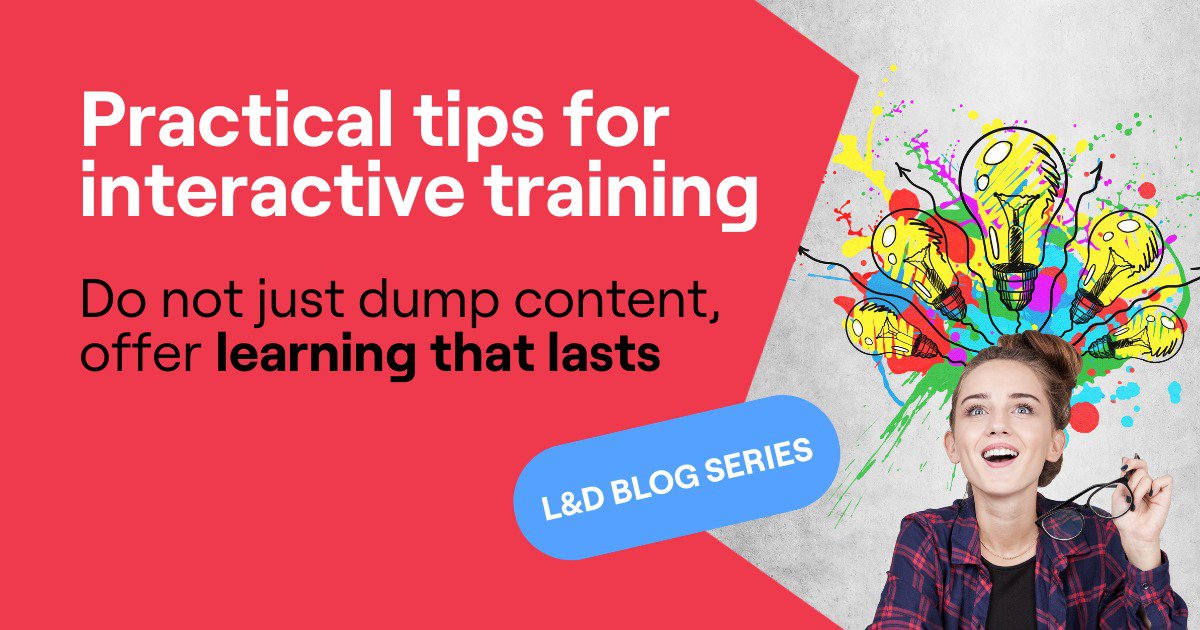
.avif)
How to make e-learning interactive: 10 proven ways
Want to know how to make e-learning interactive? Explore 10 practical ways to keep learners engaged and transform training into lasting knowledge.
.avif)